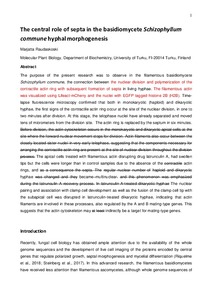The central role of septa in the basidiomycete Schizophyllum commune hyphal morphogenesis
Marjatta Raudaskoski
https://urn.fi/URN:NBN:fi-fe2021042824283
Tiivistelmä
The purpose of the present research was to observe in the filamentous basidiomycete Schizophyllum commune,
the connection between the nuclear division and polymerization of the
contractile actin ring with subsequent formation of septa in living
hyphae. The filamentous actin was visualized using Lifeact-mCherry and
the nuclei with EGFP tagged histone 2B (H2B). Time-lapse fluorescence
microscopy confirmed that in monokaryotic and dikaryotic hyphae, the
first signs of the contractile actin ring occur at the site of the
nuclear division, in one to two minutes after division. At this stage,
the telophase nuclei have moved tens of micrometers from the division
site. The actin ring is replaced by the septum in six minutes. The
apical cells treated with filamentous actin disrupting drug latrunculin
A, had swollen tips but the cells were longer than in control samples
due to the absence of the actin rings. The nuclear pairing and
association with clamp cell development as well as the clamp cell fusion
with the subapical cell was disrupted in latrunculin-treated dikaryotic
hyphae, indicating that actin filaments are involved in these
processes, also regulated by the A and B mating-type genes. This
suggests that the actin cytoskeleton may indirectly be a target for
mating-type genes.
Kokoelmat
- Rinnakkaistallenteet [27094]
